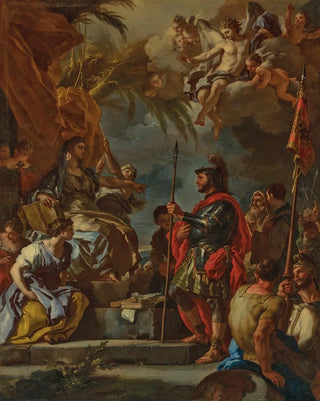Painting Deborah and Barak - Francesco Solimena | Art print


View from behind

Frame (optional)
In the fascinating universe of baroque art, the artwork "Déborah et Barak" by Francesco Solimena stands out for its dramatic intensity and narrative depth. This painting, which depicts a biblical episode from the Book of Judges, captures a pivotal moment in Hebrew history. The scene highlights the strength of female leadership through the character of Déborah, prophetess and judge, and the bravery of Barak, the military leader. Together, they embody the alliance between wisdom and courage, a timeless theme that still resonates today. The art print Déborah et Barak - Francesco Solimena invites viewers to immerse themselves in this powerful dynamic, where faith and determination intertwine to overcome adversities.
Style and uniqueness of the work
Solimena's style is characterized by an exceptional mastery of light and color. In "Déborah et Barak," the figures are beautifully modeled, with expressions and postures conveying palpable emotional intensity. The artist uses striking contrasts between shadows and highlights to emphasize the dramatic tension of the scene. The drapery of the clothing, rendered with remarkable precision, demonstrates his skill in capturing movement and texture. Furthermore, the composition is carefully orchestrated, with each element arranged to guide the viewer's eye through the artwork. The warm, rich colors, typical of the baroque, add an almost tactile dimension to the painting, transforming each glance into an immersive experience.
The artist and his influence
Francesco Solimena, born in 1657 in Canosa di Puglia, is one of the major representatives of Neapolitan baroque. His work is marked by a desire to tell stories through dynamic compositions and expressive characters. Solimena successfully established himself in the artistic landscape of his time, influencing many contemporary and future artists. His ability to fuse classical elements with stylistic innovations made him a pioneer in the interpretation of religious and mythological themes. His career, marked by success, testifies to a deep commitment to art and culture, with

Matte finish

View from behind

Frame (optional)
In the fascinating universe of baroque art, the artwork "Déborah et Barak" by Francesco Solimena stands out for its dramatic intensity and narrative depth. This painting, which depicts a biblical episode from the Book of Judges, captures a pivotal moment in Hebrew history. The scene highlights the strength of female leadership through the character of Déborah, prophetess and judge, and the bravery of Barak, the military leader. Together, they embody the alliance between wisdom and courage, a timeless theme that still resonates today. The art print Déborah et Barak - Francesco Solimena invites viewers to immerse themselves in this powerful dynamic, where faith and determination intertwine to overcome adversities.
Style and uniqueness of the work
Solimena's style is characterized by an exceptional mastery of light and color. In "Déborah et Barak," the figures are beautifully modeled, with expressions and postures conveying palpable emotional intensity. The artist uses striking contrasts between shadows and highlights to emphasize the dramatic tension of the scene. The drapery of the clothing, rendered with remarkable precision, demonstrates his skill in capturing movement and texture. Furthermore, the composition is carefully orchestrated, with each element arranged to guide the viewer's eye through the artwork. The warm, rich colors, typical of the baroque, add an almost tactile dimension to the painting, transforming each glance into an immersive experience.
The artist and his influence
Francesco Solimena, born in 1657 in Canosa di Puglia, is one of the major representatives of Neapolitan baroque. His work is marked by a desire to tell stories through dynamic compositions and expressive characters. Solimena successfully established himself in the artistic landscape of his time, influencing many contemporary and future artists. His ability to fuse classical elements with stylistic innovations made him a pioneer in the interpretation of religious and mythological themes. His career, marked by success, testifies to a deep commitment to art and culture, with
12,34 €






